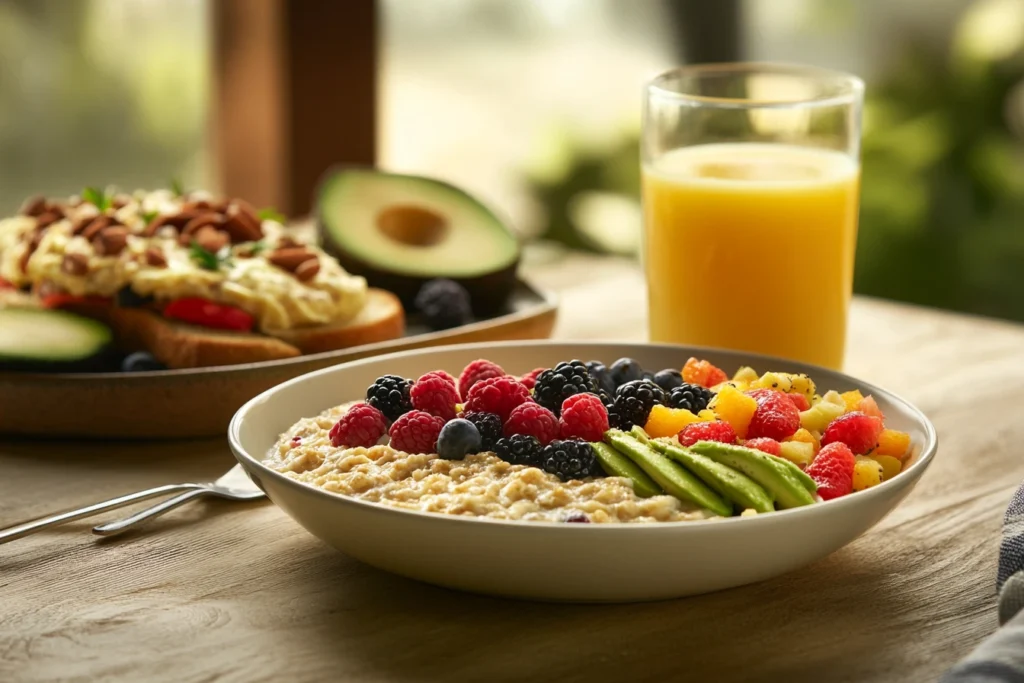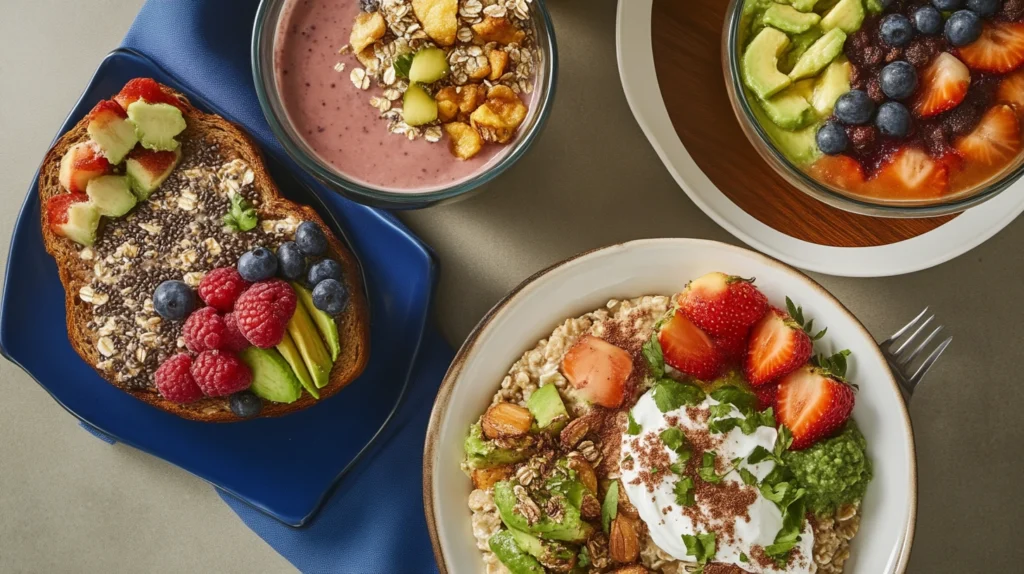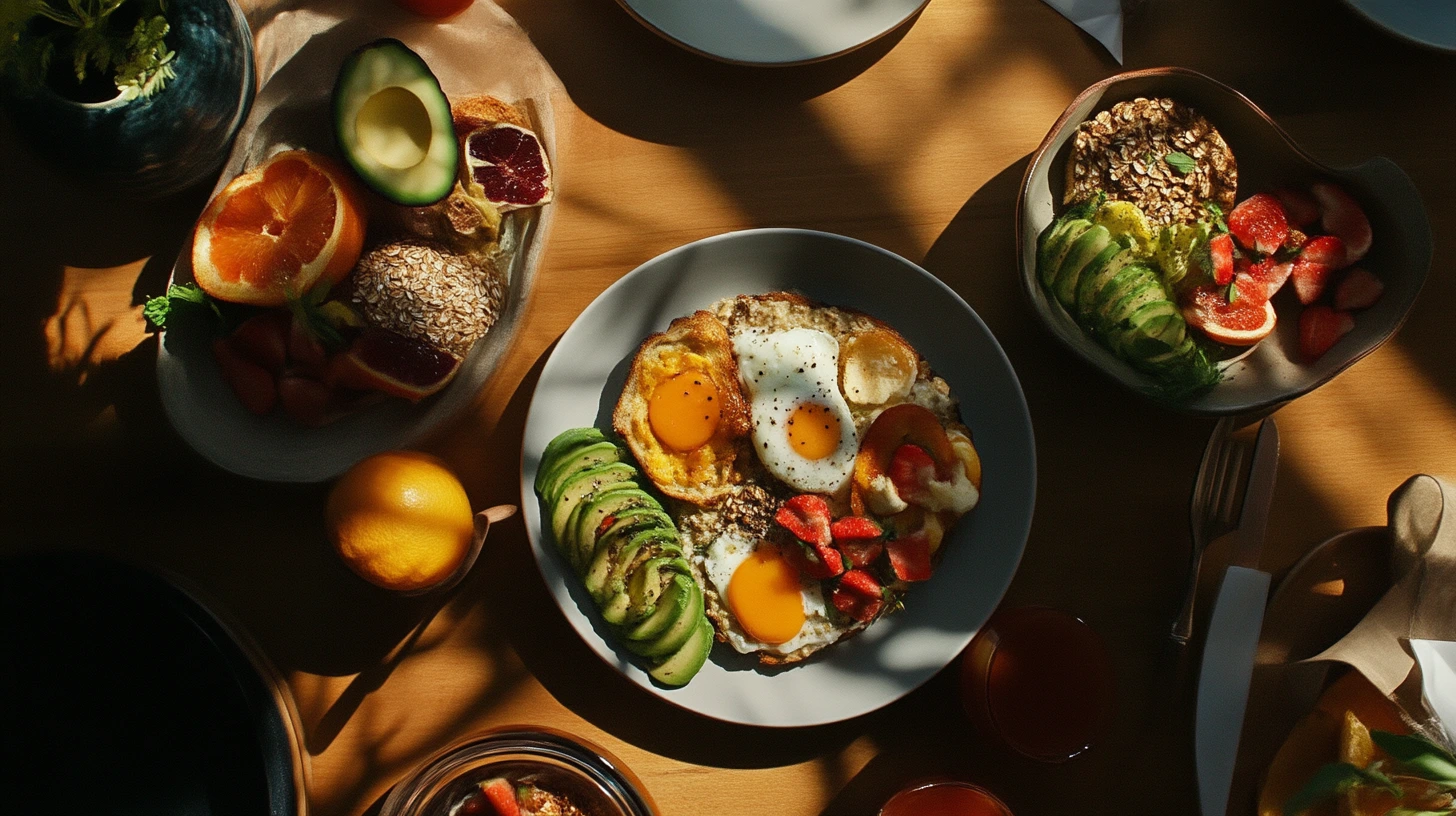Breakfast is often hailed as the most important meal of the day, and for good reason. The healthiest breakfast dish not only staves off hunger but also kickstarts your metabolism, stabilizes blood sugar levels, and fuels your body for the day ahead. The choices we make in the morning have a profound impact on our energy levels, mental clarity, and overall health.
The key to a healthy breakfast lies in its nutritional value. It’s not about eating less or skipping meals; it’s about selecting foods rich in essential nutrients that keep you satiated and energized. From fiber-rich grains to protein-packed eggs, protein-rich meat recipes, and vibrant fruits, the possibilities for a nutritious breakfast are endless.
But with so many options, what truly qualifies as the healthiest breakfast dish? This article dives deep into the science behind a balanced morning meal, highlights some top breakfast dishes, and offers tips to tailor them to your lifestyle.
Let’s uncover the secrets to starting your day the healthiest way possible!
The Science Behind What Makes the Healthiest Breakfast Dish
A healthy breakfast is more than just a meal; it’s a critical component of a well-balanced lifestyle. Understanding the science behind what makes a breakfast healthy can help you make informed choices and prioritize ingredients that fuel your body and mind.

Nutritional Components of the Healthiest Breakfast Dish
A balanced breakfast should include the following essential components:
- Proteins:
Proteins are the building blocks of the body and essential for muscle repair and growth. Breakfasts high in protein, such as eggs, Greek yogurt, or plant-based alternatives like tofu, keep you feeling full longer and prevent mid-morning hunger pangs. - Carbohydrates:
Carbohydrates are the body’s primary energy source. Opt for complex carbohydrates like oats, whole-grain bread, or quinoa, as they provide sustained energy without causing blood sugar spikes. - Healthy Fats:
Incorporating healthy fats, such as those found in avocados, nuts, seeds, and olive oil, ensures brain function and hormone regulation. These fats are essential for long-term energy release. - Vitamins and Minerals:
Fruits and vegetables are the best sources of vitamins and minerals. Adding a variety of colorful produce to your breakfast guarantees a dose of antioxidants, fiber, and essential nutrients.
Why a Nutrient-Dense Meal is the Healthiest Breakfast Dish
A breakfast that meets your nutritional needs offers several health benefits:
- Boosts Metabolism:
Eating breakfast signals your body to kickstart metabolism after the overnight fasting period. This can improve energy expenditure throughout the day. - Enhances Focus and Productivity:
A nutrient-packed breakfast, particularly one rich in proteins and complex carbs, fuels your brain for better concentration and cognitive performance. - Aids in Weight Management:
Research suggests that individuals who eat a healthy breakfast tend to consume fewer calories later in the day, which may help with weight control.
The Role of Glycemic Index in Breakfast Choices
The glycemic index (GI) of foods plays a crucial role in maintaining energy and preventing sugar crashes. Foods with a low GI are digested slowly, leading to gradual energy release, while high-GI foods can cause spikes and dips in blood sugar levels.
- Low-GI Foods:
Examples include oats, quinoa, and most fruits like berries and apples. Incorporating these into your breakfast helps sustain energy and avoid feelings of sluggishness. - High-GI Foods to Avoid:
Pastries, sugary cereals, and white bread cause rapid blood sugar fluctuations and should be minimized.
By understanding the nutritional makeup of your breakfast and prioritizing foods with low glycemic indices, you can create a meal that not only satisfies but also supports your long-term health goals.
What Are the Healthiest Breakfast Dishes? Examples to Try
When it comes to healthy breakfasts, the key lies in combining nutrient-rich ingredients to create a meal that is both satisfying and nourishing. Below are some of the top choices for a healthy breakfast, each offering a unique combination of flavors and health benefits.

Why Oatmeal with Fresh Fruit is a Healthy Breakfast Choice
Oatmeal is often referred to as a breakfast superfood, and for good reason. Made from whole grains, oatmeal is rich in soluble fiber, which helps lower cholesterol levels and improves heart health.
- Why It’s Healthy:
The combination of oats, fresh fruit, and nuts creates a nutrient-dense dish packed with vitamins, minerals, antioxidants, and healthy fats. - How to Prepare:
Cook oats in water or milk, then top with sliced bananas, berries, or apples. Add a handful of almonds, walnuts, or chia seeds for a crunchy texture and extra omega-3 fatty acids.
Greek Yogurt Parfait: A Healthiest Breakfast Dish Option
Greek yogurt is a protein powerhouse and an excellent source of probiotics, which support gut health.
- Why It’s Healthy:
Adding berries and seeds such as flaxseeds or pumpkin seeds boosts the dish’s fiber and antioxidant content. The natural sweetness of berries reduces the need for added sugars. - How to Prepare:
Layer Greek yogurt with a mix of strawberries, blueberries, and raspberries. Sprinkle with a blend of chia seeds and crushed nuts for added texture and nutrition.
Vegetable Omelet with Whole-Grain Toast
Eggs are a versatile breakfast staple, providing high-quality protein and a wealth of nutrients, including choline, which is essential for brain health.
- Why It’s Healthy:
A vegetable omelet adds essential vitamins and minerals while whole-grain toast provides fiber for better digestion and sustained energy. - How to Prepare:
Whisk eggs with a splash of milk, then cook with a mix of sautéed vegetables such as spinach, bell peppers, and tomatoes. Serve alongside a slice of whole-grain toast for a balanced meal.
Smoothie Bowls with Superfoods
Smoothie bowls are not only visually appealing but also an excellent way to pack fruits, vegetables, and superfoods into your morning meal.
- Why It’s Healthy:
Combining ingredients like spinach, kale, and bananas with toppings such as granola, goji berries, and hemp seeds provides a mix of vitamins, minerals, and antioxidants. - How to Prepare:
Blend a base of frozen fruits, almond milk, and a handful of leafy greens. Pour into a bowl and top with your favorite nutrient-dense ingredients like coconut flakes and cacao nibs.
Avocado Toast with Poached Eggs
Avocado toast has become a modern breakfast classic for its combination of simplicity and nutrition.
- Why It’s Healthy:
Avocados are rich in monounsaturated fats that support heart health, while eggs provide protein and essential amino acids. Pairing these with whole-grain bread enhances the meal’s fiber content. - How to Prepare:
Mash a ripe avocado and spread it over a slice of toasted whole-grain bread. Top with a poached egg and season with salt, pepper, and a sprinkle of chili flakes or microgreens for an extra kick.
These dishes showcase the endless variety of healthy breakfast options available. By incorporating these meals into your routine, you can ensure that your day starts on the right note, both nutritionally and gastronomically.
Tips for Creating the Healthiest Breakfast Dish
Everyone has unique tastes, dietary preferences, and nutritional needs, so customizing your breakfast ensures it aligns with your lifestyle. Here are practical tips to help you create a breakfast that’s both enjoyable and nutritionally balanced.
Incorporating Diverse Food Groups
To build a well-rounded breakfast, aim to include a variety of food groups:
- Protein Sources:
Incorporate options like eggs, lean meats, tofu, Greek yogurt, or plant-based proteins to keep you full and energized. - Complex Carbohydrates:
Use whole grains such as oats, whole-grain bread, quinoa, or brown rice to provide sustained energy and support digestion. - Healthy Fats:
Add avocados, nuts, seeds, or a drizzle of olive oil to your meals. These fats help regulate hormones and support brain health. - Fruits and Vegetables:
Include fresh or frozen fruits and vegetables for vitamins, minerals, and antioxidants. They add color and natural sweetness to your breakfast.
Avoiding Sugary and Processed Foods
While it might be tempting to grab a sugary cereal or pastry, these foods offer little nutritional value and can cause energy crashes later in the day.
- Read Labels:
Check the sugar content in breakfast products like granola bars or flavored yogurts. Opt for unsweetened versions whenever possible. - Replace Processed Foods:
Swap sugary cereals with homemade granola or whole-grain options. Replace white bread with sprouted grain or whole-grain bread. - Choose Natural Sweeteners:
Use honey, maple syrup, or fresh fruit as natural alternatives to refined sugar.
Adjusting Portions for Activity Level
Your breakfast should reflect your energy needs, which vary depending on your daily activities.
- For Active Individuals:
If you exercise in the morning or have a physically demanding job, focus on high-protein and carbohydrate-rich breakfasts to fuel your activities. For example, a smoothie bowl with added protein powder or a hearty oatmeal dish with nuts and seeds can be ideal. - For Sedentary Days:
On days with minimal physical activity, scale back portion sizes and prioritize lighter options like a vegetable omelet or a small bowl of Greek yogurt with fruit.
Exploring Plant-Based Options
Plant-based diets are gaining popularity for their health and environmental benefits. Even if you’re not fully vegan or vegetarian, incorporating plant-based breakfasts can diversify your nutrient intake.
- Try Dairy Alternatives:
Use almond, soy, or oat milk instead of dairy milk. Substitute regular yogurt with plant-based alternatives made from coconut or cashews. - Plant Proteins:
Include options like chickpea flour pancakes, tofu scrambles, or smoothies with pea protein powder.
Make-Ahead Breakfast Ideas
For busy mornings, preparing your breakfast ahead of time can save you time and ensure you still have a healthy start to your day.
- Overnight Oats:
Mix oats, milk (or a plant-based alternative), and your favorite toppings in a jar and refrigerate overnight for a grab-and-go meal. - Egg Muffins:
Whisk eggs with vegetables and bake in muffin tins for a quick, reheatable breakfast. - Smoothie Prep:
Portion out smoothie ingredients in freezer bags so you can blend them quickly in the morning.
By tailoring your breakfast to your preferences and needs, you can enjoy a meal that’s not only delicious but also perfectly aligned with your health goals.
FAQs About the Healthiest Breakfast Dish
Breakfast is a topic that sparks a lot of curiosity. Below, we address some of the most common questions about starting your day with a healthy meal.
Is Skipping the Healthiest Breakfast Dish Unhealthy?
Skipping breakfast has been a topic of debate. While some research suggests it’s not always harmful, missing breakfast can lead to:
- Overeating Later in the Day:
Skipping breakfast may cause you to feel hungrier later, leading to excessive calorie intake during lunch or dinner. - Reduced Energy Levels:
Without breakfast, you might experience low blood sugar, making you feel tired and less productive. - Nutritional Deficiencies:
Breakfast often provides essential nutrients like fiber, calcium, and vitamins. Skipping it could result in missing out on these key elements.
However, if you’re practicing intermittent fasting, consult with a healthcare professional to ensure your eating pattern aligns with your health needs.
Can I eat the same breakfast every day?
Eating the same breakfast daily can be convenient, but there are pros and cons to consider:
- Pros:
- Simplifies meal prep.
- Ensures consistency in nutrient intake if the meal is well-balanced.
- Cons:
- Limits exposure to a variety of nutrients found in different foods.
- Can lead to meal fatigue, reducing enjoyment.
To strike a balance, rotate between a few healthy options, such as oatmeal, smoothies, and eggs, to diversify your diet while maintaining simplicity.
Quick Ideas for the Healthiest Breakfast Dish
For those short on time, quick yet nutritious breakfasts can be lifesavers. Here are some ideas:
- Smoothies: Blend fruits, vegetables, milk, and protein powder for a drinkable meal.
- Whole-Grain Toast: Top with peanut butter, banana slices, or mashed avocado.
- Overnight Oats: Prepare the night before for a ready-to-eat breakfast in the morning.
- Hard-Boiled Eggs: Pair with a piece of fruit for a balanced, portable meal.
Are there healthy options for sweet breakfast lovers?
If you have a sweet tooth, there are plenty of ways to enjoy a healthy and sweet breakfast without resorting to processed sugars:
- Fruit-Based Dishes: Use natural sweetness from fruits like berries, bananas, or mangoes.
- Sweetened Yogurt Alternatives: Add honey, cinnamon, or a drizzle of maple syrup to plain yogurt.
- Healthy Pancakes or Waffles: Use whole-grain or almond flour and top with fresh fruit and nut butter instead of syrup.
Heading 3: Can breakfast help with weight loss?
Yes, eating a balanced breakfast can play a significant role in weight management:
- Appetite Control: High-protein breakfasts keep you full longer, reducing overall calorie intake throughout the day.
- Improved Metabolism: Starting your day with a meal helps activate your metabolism, burning calories more efficiently.
- Healthier Choices: People who eat breakfast are less likely to snack on high-calorie, low-nutrient foods later.
Focus on nutrient-dense meals with a mix of protein, fiber, and healthy fats to maximize these benefits.
Should I avoid carbs at breakfast?
Carbohydrates are essential for energy, and there’s no need to eliminate them from breakfast. However, the type of carbs matters:
- Opt for Complex Carbs: Whole grains, fruits, and vegetables provide sustained energy and valuable nutrients.
- Avoid Refined Carbs: Minimize intake of pastries, white bread, and sugary cereals, which can lead to energy crashes.
Incorporating the right carbs in moderation supports your overall health and keeps you energized.
Conclusion
A healthy breakfast is a cornerstone of a balanced lifestyle, providing the energy and nutrients your body needs to thrive throughout the day. From the science-backed benefits of a nutrient-dense morning meal to specific dishes like oatmeal, smoothie bowls, and avocado toast—or even protein-packed meat options—it’s clear that breakfast is an opportunity to nourish both body and mind.
By prioritizing whole, unprocessed foods and incorporating a variety of proteins (like those in our guide to healthy meat breakfasts), complex carbohydrates, healthy fats, and vitamins, you can create a breakfast that aligns with your health goals. Customizing your morning meal to fit your preferences, activity levels, and dietary needs ensures it remains enjoyable and sustainable.
It’s important to remember that breakfast doesn’t have to be elaborate or time-consuming. Simple, nutritious options like Greek yogurt with berries, overnight oats, or a quick smoothie can make a world of difference. Moreover, listening to your body’s hunger cues and tailoring your meals can help you find the perfect balance for your lifestyle. For those curious about optimal choices, explore the healthiest breakfast meats to elevate your morning routine.
So, what is the healthiest breakfast dish? The answer lies in choosing meals that are rich in nutrients, customizable to your taste, and tailored to your unique needs. With a little planning and creativity, you can transform breakfast into a daily ritual that sets a positive tone for the hours ahead.


1 thought on “What is the Healthiest Breakfast Dish? Top Nutritious Choices”